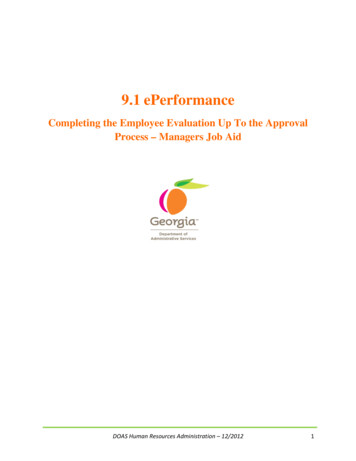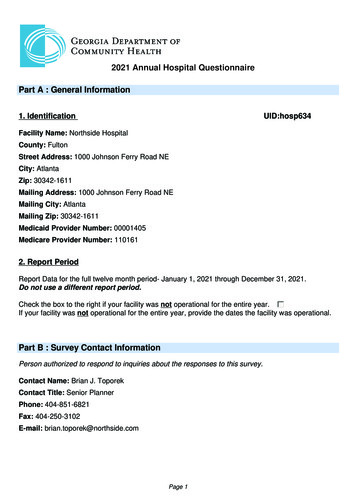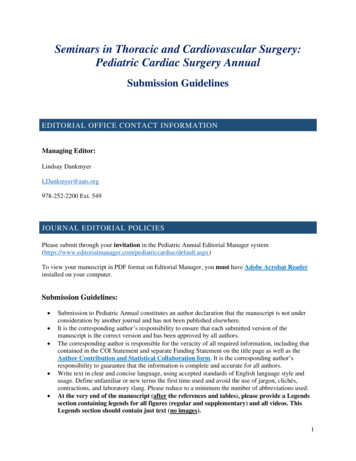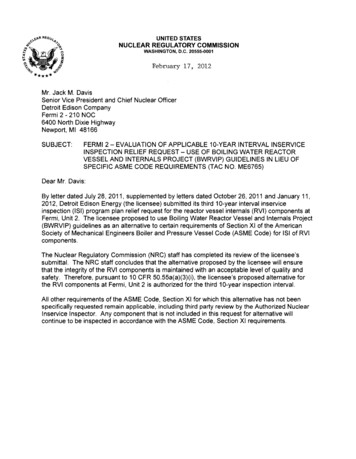
Transcription
UNITED STATESNUCLEAR REGULATORY COMMISSIONWASHINGTON, D.C. 20555·0001February 17, 2012Mr. Jack M. DavisSenior Vice President and Chief Nuclear OfficerDetroit Edison CompanyFermi 2 - 210 NOC6400 North Dixie HighwayNewport, M I 48166SUBJECT:FERMI 2 - EVALUATION OF APPLICABLE 10-YEAR INTERVAL INSERVICEINSPECTION RELIEF REQUEST - USE OF BOILING WATER REACTORVESSEL AND INTERNALS PROJECT (BWRVIP) GUIDELINES IN LIEU OFSPECIFIC ASME CODE REQUIREMENTS (TAC NO. ME6765)Dear Mr. Davis:By letter dated July 28, 2011, supplemented by letters dated October 26, 2011 and January 11,2012, Detroit Edison Energy (the licensee) submitted its third 10-year interval inserviceinspection (lSI) program plan relief request for the reactor vessel internals (RVI) components atFermi, Unit 2. The licensee proposed to use Boiling Water Reactor Vessel and Internals Project(BWRVIP) guidelines as an alternative to certain requirements of Section XI of the AmericanSOciety of Mechanical Engineers Boiler and Pressure Vessel Code (ASME Code) for lSI of RVIcomponents.The Nuclear Regulatory Commission (NRC) staff has completed its review of the licensee'ssubmittal. The NRC staff concludes that the alternative proposed by the licensee will ensurethat the integrity of the RVI components is maintained with an acceptable level of quality andsafety. Therefore, pursuant to 10 CFR 50.55a(a)(3)(i), the licensee's proposed alternative forthe RVI components at Fermi, Unit 2 is authorized for the third 1O-year inspection interval.All other requirements of the ASME Code, Section XI for which this alternative has not beenspecifically requested remain applicable, including third party review by the Authorized NuclearInservice Inspector. Any component that is not included in this request for alternative willcontinue to be inspected in accordance with the ASME Code, Section XI requirements.
J. M. Davis- 2 In case of any further questions or comments, please contact Project Manager, Mahesh Chawlaat wn A. Williams, ChiefPlant Licensing Branch 111-1Division of Operating Reactor LicensingOffice of Nuclear Reactor RegulationDocket No. 50-341Enclosure: Safety Evaluationcc w/encl: Distribution via ListServ
UNITED STATESNUCLEAR REGULATORY COMMISSIONWASHINGTON, D.C. 20555-0001SAFETY EVALUATION BY THE OFFICE OF NUCLEAR REACTOR REGULATIONFOR APPLICABLE 10-YEAR INTERVAL INSERVICE INSPECTIONRELIEF REQUEST FOR USE OF BOILING WATER REACTOR VESSEL INTERNALSPROGRAM GUIDELINES IN LIEU OF SPECIFIC ASME CODE REQUIREMENTSFERMI, UNIT 2DOCKET NO. 50-3411.0 INTRODUCTIONBy letter dated July 28,2011 (Agencywide Documents Access and Management System(ADAMS) Accession No. ML 112101480), supplemented by letters dated October 26,2011(ADAMS Accession No. ML 112991389), and January 11,2012 (ADAMS Accession No.ML 120120278), Detroit Edison Energy (the licensee) submitted its third 10-year intervalinservice inspection (lSI) program plan relief request for the reactor vessel internals (RVI)components at Fermi, Unit 2. The licensee proposed to use Boiling Water Reactor Vessel andInternals Project (BWRVIP) guidelines as an alternative to certain requirements of Section XI ofthe American Society of Mechanical Engineers Boiler and Pressure Vessel Code (ASME Code)for lSI of RVI components.2.0 REGULATORY REQUIREMENTSThe lSI of ASME Code Class 1,2, and 3 components is performed in accordance withSection XI of the ASME Code as required by Title 10 Code of Federal Regulations (10 CFR)50.55a(g), except where specific relief has been granted by the Nuclear Regulatory Commission(NRC) pursuant to 10 CFR 50.55a(g)(6)(i). It is stated in 10 CFR 50.55a(a)(3) that alternativesto the requirements of 10 CFR 50.55a(g) may be used, when authorized by the NRC if: (i) theproposed alternatives would provide an acceptable level of quality and safety or (ii) compliancewith the specified requirements would result in hardship or unusual difficulty without acompensating increase in the level of quality and safety.Pursuant to 10 CFR 50.55a(g)(4), ASME Code Class 1,2, and 3 components (includingsupports) shall meet the requirements, except the design and access provisions and thepreservice examination requirements, set forth in the ASME Code, Section XI, "Rules for lSI ofNuclear Power Plant Components," to the extent practical within the limitations of design,geometry, and materials of construction of the components. The regulations require that lSIexamination of components and system pressure tests conducted during the first 10-yearinterval and subsequent intervals comply with the requirements in the latest edition andEnclosure
- 2 addenda of Section XI of the ASME Code incorporated by reference in 10 CFR 50.55a(b),twelve months prior to the start of the 120-month interval, subject to the limitations andmodifications listed therein. The applicable ASME Code of record for the third 10-year lSIinterval for Fermi, Unit 2 is ASME Code, Section XI, 2001 Edition, through 2003 Addenda.3.0 TECHNICAL EVALUATION3.1 LlCENCEE'S EVALUATIONThe Components for Which an Alternative is RequestedIn its submittal dated July 28, 2011, the licensee included an alternative inspection program forthe following ASME Code, Section XI, Class 1, Examination Categories that are applicable tothe RVI components at Fermi, Unit 2.ASME Code, Section XI, Class 1, Examination Categories 8-N-1 and 8-N-2, Code ItemNumbers 813.10, Vessel Interior, 813.20, Interior Attachments within 8eltline Region,813.30, Interior Attachments 8eyond 8eltline Region, and 813.40, Core SupportStructure.Examination Requirements From Which an Alternative is RequestedASME Code, Section XI requires the visual examination (VT) of certain RVI components. Theseexaminations are included in Table IW8-2500-1, Categories 8-N-1 and 8-N-2, and identifiedwith the following item numbers: 813.10 - Examine accessible areas of the RV interior each period using a techniquewhich meets the requirements for a VT-3 examination, as defined in paragraphIWA-2213 of the ASME Code, Section XI. 813.20 - Examine interior attachment welds within the beltline region each interval usinga technique which meets the requirements for a VT-1 examination as defined inparagraph IWA-2211 of the ASME Code, Section XI. 813.30 - Examine interior attachment welds beyond the beltline region each intervalusing a technique which meets the requirements for a VT-3 examination, as defined inparagraph IWA-2213 of the ASME Code, Section XI. 813.40 - Examine surfaces of the core support structure each interval using a techniquewhich meets the requirements for a VT-3 examination, as defined in paragraphIWA-2213 of the ASME Code, Section XI.These examinations are performed to assess the structural integrity of the RVI components.Licensee's 8asis for Requesting an Alternative and Justification for Granting ReliefThe licensee stated that the alternative inspections (described below) will maintain an adequatelevel of quality and safety of the affected welds and components and will not adversely impact
-3 the health and safety of the public. As part of its justification for the relief, the licensee statedthat BWR RVI components are now being examined in accordance with BWRVIP guidelines.The BWRVIP has established a reporting protocol for the examination results and deviations.These guidelines have been written to address the examination of safety significant RVIcomponents using appropriate methods and reexamination frequencies. The licensee alsonoted that the NRC has agreed with the BWRVIP approach, in principle, and has issued safetyevaluations (SEs) for these guidelines. [Note: "in principle" means that, for some reports, finalSEs have been written, but the final BWRVIP acceptance reports which incorporate these SEsfor some of the reports may not have been issued]. Relief from examinations in Table IWB 2500-1 of the ASME Code are requested pursuant to 10 CFR 50.55a(a)(3)(i).Alternative ExaminationIn lieu of the requirements of the 2001 Edition and 2003 Addenda of the ASME Code,Section XI, the licensee proposed to examine the Fermi, Unit 2 RVI components in accordancewith BWRVIP Guideline requirements. The particular guidelines that are applicable to thevarious RVI components are: BWRVIP-03NP, "BWR Vessel and Internals Project, BWR Vessel Internals Project,Reactor Pressure Vessel and Internal Examination Guidelines" (ADAMS Accession No.ML092580272)BWRVIP-14NP-A "BWR Vessel and Internals Project, BWR Evaluation of Crack Growthin BWR Stainless Steel RPV Internals," (ADAMS Accession No. ML 101880724)BWRVIP-18-A, "BWR Vessel and Internals Project, BWR Core Spray InternalsInspection and Flaw Evaluation Guidelines" (Proprietary information, not publiclyavailable)BWRVIP-25, "BWR Vessel and Internals Project, BWR Core Plate Inspection and FlawEvaluation Guidelines" (Proprietary information, not publicly available)BWRVIP-26-A, "BWR Vessel and Internals Project, BWR Top Guide Inspection andFlaw Evaluation Guidelines" (Proprietary information, not publicly available)BWRVIP-27-A, "BWR Vessel and Internals Project, BWR Standby Liquid ControlSystem/Core Plate 6P Inspection and Flaw Evaluation Guidelines" (ADAMS AccessionNo. ML041700446)BWRVIP-38, "BWR Vessel and Internals Project, BWR Shroud Support Inspection andFlaw Evaluation Guidelines" (Proprietary information, not publicly available)BWRVIP-41, "BWR Vessel and Internals Project, BWR Jet Pump Assembly Inspectionand Flaw Evaluation Guidelines" (Proprietary information, not publicly available)BWRVIP-47-A, "BWR Vessel and Internals Project, BWR Lower Plenum Inspection andFlaw Evaluation Guidelines" (Proprietary information, not publicly available)BWRVIP-48-A, "BWR Vessel and Internals Project, BWR VessellD Attachment WeldInspection and Flaw Evaluation Guidelines" (Proprietary information, not publiclyavailable)BWRVIP-76NP, "BWR Vessel and Internals Project, BWR Core Shroud Inspection andFlaw Evaluation Guidelines" (ADAMS Accession No. ML003688790)BWRVIP-94NP, "BWR Vessel and Internals Project, Program Implementation Guide"(ADAMS Accession No. ML 11271A058)BWRVIP-100NP-A, "BWR Vessel and Internals Project, BWR Updated Assessment ofFracture Toughness of Irradiated Stainless Steel for BWR Core Shroud" (ADAMS
- 4 Accession No. ML080110645)BWRVIP-139NP-A, "BWR Vessel and Internals Project, Steam Dryer Inspection andFlaw Evaluation Guidelines," (ADAMS Accession No. ML 101270123)BWRVIP-183NP "BWR Vessel and Internals Project, Top Guide Grid Beam Inspectionand Flaw Evaluation Guidelines," (ADAMS Accession No. ML080220433)The licensee made a statement that any deviation from the aforementioned BWRVIP guidelinesfor the duration (third 10-year lSI interval) of proposed alternative will be communicated to thestaff per the BWRVIP deviation process. At Fermi, Unit 2, the only deviation from the BWRVIPguidelines is associated with the inspection of the core plate bolting.Irradiated stainless steel RVI components, especially, core shroud welds exposed to a neutronfluence value which exceeds the threshold limit are susceptible to loss of fracture toughness. Inthat context, the licensee stated that it would use the reduced fracture toughness values asspecified in BWRVIP-100NP-A for its flaw evaluation of the cracked core shroud welds.In Enclosure 1 of the July 28, 2011 submittal, the licensee provided a comparison of therequired ASME Code, Section XI, Category B-N-1 and B-N-2 examination requirements with theabove current BWRVIP Guideline requirements that are applicable to the Fermi, Unit 2. InEnclosure 2, of the July 28, 2011 submittal the licensee provided, as an example, additionalinformation regarding the BWRVIP inspection requirements for the following welds of the RVIcomponents and their subcomponents representing each of the aforementioned ASME Code,Section XI, category/item numbers (Item Numbers B13.10, B13.20, B13.30, and B13.40).Core SprayJet PumpCore ShroudCore Shroud Support and Core Support StructureTop GuideInterior Attachment WeldsIn Enclosure 3 of the July 28, 2011 submittal, the licensee provided inspection history of thefollowing RVI components: core shroud, core spray piping, top guide, core plate, stand-by-liquidsystem, jet pump assembly, control rod guide tube assembly, stub tube, in-core housing,instrumentation penetrations, vessel inside diameter brackets, and steam dryers. InEnclosure 3, the licensee also provided information with respect to the extent of active agingdegradation that was observed in the aforementioned components and addressed theappropriate corrective actions that were taken to mitigate the aging degradation in the RVIcomponents.The licensee stated that these examples demonstrated that the inspection techniques that arerecommended by the BWRVIP inspection guidelines are superior to the inspection techniquesmandated by the ASME Code, Section XI, lSI program. Additionally, these examples confirmedthat the BWRVIP inspection guidelines require more frequent inspections of the RVIcomponents than the corresponding ASME Code, Section XI, lSI program. The licenseeclaimed that by implementing the BWRVIP inspection guidelines the aging degradation of theRVI components can be identified in a timely manner so that proper corrective action can betaken to restore the integrity of the applicable RVI components. Therefore, the licenseeconcluded that implementation of the BWRVIP inspection guidelines for the Fermi, Unit 2 RVIcomponents would provide an acceptable level of quality and safety.
-5 3.2 STAFF EVALUATIONThe NRC staff reviewed the information provided by the licensee in its submittal dated July 28,2011, which included technical bases for its proposed alternative to the ASME Code, Section XI,lSI requirements for the RVI components at Fermi, Unit 2. The staff reviewed the status of eachof the referenced BWRVIP guidance documents and found all of the referenced BWRVIPreports to be acceptable. The staff did, however, identify some issues which required additionalclarification by the licensee. The following paragraphs address the staff's requests for additionalinformation (RAls), the licensee's responses, and the staff's evaluation of the RAls.In response to RAI #1, by a letter October 26, 2011, the licensee stated that it providedinspection requirements and inspection frequencies for the RVI components at Fermi, Unit 2similar to those addressed in the Exelon submittal (ADAMS Accession Number ML071140082)which was accepted by the staff. Table 1 in Enclosure 1, and the information in Enclosures 2and 3 provide detailed examples of the inspections of the RVI components at Fermi, Unit 2.After further review, the staff finds the response acceptable because the licensee adequatelyaddressed the inspection results, inspection methods used, and frequency of inspections.Therefore, the staff considers that its concern related to RAI #1 is resolved.In response to RAI #2, by a letter October 26, 2011, the licensee stated that it developed an RVIinspection program which complies with the BWRVIP-94NP, "BWR Vessel and Internals Project,Program Implementation Guide" (ADAMS Accession No. ML 11271A058). The licensee furtherstated that revised versions of the BWRVIP guidelines will be implemented only after they areapproved by the staff. The staff finds this response acceptable because at the Fermi, Unit 2, thelicensee's implementation of the BWRVIP inspection guidelines is consistent with the BWRVIPImplementation Guidelines. Therefore, staff considers that its concern related to RAI #2 isresolved.In response to RAI #3, in its letter dated October 26, 2011, the licensee acknowledged thatthere are furnace sensitized stainless steel attachment welds which included guide rodbrackets, steam dryer support lugs, core spray piping brackets, feed water brackets,surveillance brackets and, jet pump brackets at Fermi, Unit 2. These components wereinspected as per their relevant BWRVIP reports and thus far, no cracking was observed. Theinspection techniques and the frequency of inspections of some of these components exceedthe ASME Code, Section XI requirements. The licensee reiterated that it did not performadditional augmented inspections on these components. Absence of cracking in the furnacesensitized RVI components is a good indication that thus far, there is no active agingdegradation in these components. The implementation of the inspection criteria addressed inthe applicable BWRVIP reports would be adequate in identifying any active aging degradationthat could occur in the future in these components. Therefore, the staff determined that thisissue is adequately resolved.Based on the review of the Enclosure 3 in the July 28, 2011 submittal, the staff noted that thelicensee was complying with the inspection guidelines addressed in BWRVIP-139NP-A, "BWRVessel and Internals Project, Steam Dryer Inspection and Flaw Evaluation Guidelines," (ADAMSAccession No. ML 101270123) and the BWRVIP-26-A, and the BWRVIP-183, "BWRVIP Top
-6 Guide Beam Inspection and Flaw Evaluation Guidelines," (ADAMS Accession No.ML080220433) reports related to Steam Dryer Inspection and Flaw Evaluation Guidelines, andthe BWRVIP reports related to the Top Guide Grid Beam Inspection and Flaw EvaluationGuidelines, for managing aging degradation in steam dryer and top guide components,respectively. Since these reports include adequate inspection guidelines, the staff determinedthat adoption of these inspection guidelines for the aforementioned RVI components wouldeffectively enable the licensee to identify any active aging degradation in a timely manner.Therefore, the issue related to RAI #4 is adequately resolved.In response to RAI #5, the licensee, by a letter dated October 26, 2011, stated that itimplemented the inspection guidelines which were originally a part of the NUREG-0619, "BWRFeedwater Nozzle and Control Rod Drive (CRD) Return Line Nozzle Cracking." In addition, itimplemented inspection program addressed in GE-NE-523-A71-0594-A, Revision 1, (proprietaryinformation, not publicly available). Per these reports, the licensee performed ultrasonic testingon the CRD return line nozzle and feedwater nozzle. The licensee further stated that frequentinspections of the sparger hole nozzles showed no active aging degradation. Based on theresponse, the staff concludes that by implementing the inspections addressed in theaforementioned reports, the licensee would be able to adequately manage the agingdegradation in the subject components. Therefore, this issue is adequately resolved.In response to the staff's RAI #6, the licensee by a letter dated October 26, 2011, stated thatFermi, Unit 2 does not have a core shroud support leg weld (H12), and, therefore, the H12 weldwas not included in Table 1 of the Enclosure 1 of the submittal dated July 28, 2011. The staffaccepts this response and its concern related to RAI #6 is resolved.Regarding the inspection of the core plate components, in its response to RAls # 7 and 8, byletter dated October 26, 2011, the licensee stated that it did implement inspection guidelinesspecified in the BWRVIP report related to the core plate components at Fermi, Unit 2. Thelicensee further stated that, due to limited accessibility, core plate bolts were not inspected,hence, a deviation disposition was filed with the BWRVIP. Since Fermi, Unit 2 does not havewedges, the deviation disposition included an analysis which demonstrated that adversedisplacement of the core plate would not occur due to cracking and loss of preload in the coreplate bolts. Since the core plate bolts are not being inspected at Fermi, Unit 2 due to accessissues, the staff requested that the licensee submit a plant-specific analysis to the staff forreview and approval.By letter dated January 11, 2012, the licensee submitted an analysis related to the core bolts tothe staff for review. A cursory review of the fracture mechanics (FM) analysis provided in theJanuary 11, 2012 letter indicated that the FM results support the relief request until the end ofthe lSI interval, which is equivalent to 30 years of operation. This determination is based on (1)the conservative assumption of having a 360 0 circumferential flaw of depth equal to the threaddepth after an operation of 5 years, (2) the use of the 95 percentile crack growth rate asdocumented in BWRVIP-14NP-A "BWR Vessel and Internals Project, BWR Evaluation of CrackGrowth in BWR Stainless Steel RPV Internals," (ADAMS Accession No. ML 101880724), (3) thesignificant margin shown in the calculated results - loss of 0.12 percent of the preload in60 years, (4) the industry and plant-specific operating experience showing no failures anddegradation of bolts through extensive VT-3 examinations and one EVT-1 examination, and(5) a generic analysis showing only 80 percent of the bolts are necessary to resist loads duringfaulted conditions. Approving bases (3) to (5) also support the staff's determination to delay a
-7 thorough review of the generic or plant-specific FM analysis beyond this lSI interval. Thisanalysis is applicable only to this relief request and as such, it is valid only for the third lSIinterval.The staff reviewed the summary report on the inspections of the core shroud horizontal weldswhich were addressed in Enclosure 3 of the July 28, 2011 submittal and noted that theseinspections were consistent with guidelines addressed in the BWRVIP report related to coreshroud component, and thus far, no cracking was observed in these welds. In response to RAI #9,dated October 26, 2011, the licensee stated that a plant-specific analysis would be performed forthe welds that would be exposed to a fluence value exceeding the threshold limits for irradiation assisted stress corrosion cracking and neutron embrittlement. The staff expects that the plant specific analysis would comply with the guidelines provided in the BWRVIP reports related to coreshroud component. With respect to monitoring the aging degradation in H8 and H9 welds,consistent with the staff's RAI #9, the licensee agreed to include H8 and H9 welds in Table 1 of theJuly 28, 2011 submittal. After the review of the July 28, 2011 submittal, and the October 26, 2011response, the staff determined that the licensee was adequately managing the aging degradationin the core shroud component and that the inspection criteria implemented for these welds wereconsistent with the BWRVIP-76NP report. Therefore, this issue is adequately resolved.Since Alloy 182 welds are susceptible to intergranular stress corrosion cracking (IGSCC), thestaff, in a letter dated September 12, 2011 (ADAMS Accession No. ML 11255A080), in RAI #10,requested the licensee to provide information regarding the inspections and their resultsassociated with the Alloy 182 welds at Fermi, Unit 2. In its response dated October 26, 2011,the licensee stated that Alloy 182 weld metal was used for the following RVI components:integral attachment welds, access hole covers (AHC), jet pump diffuser/adapter and H7 shroudwelds. Previous inspections of these components did not reveal any indications with theexception of the AHC weld at the zero degree location. As a part of its monitoring program, thelicensee conducted subsequent inspections on the AHC weld and thus far, the crack growthseems to have stabilized. However, the licensee stated that it would continue to perform re inspections of the AHC welds, and based on future inspection results the re-inspectionfrequency would be established. The staff accepts this response because: (a) the licenseeconducted routine inspections that are consistent with the relevant BWRVIP guidelines for theAlloy 182 welds; (b) the licensee effectively demonstrated its capability in monitoring andtrending of the IGSCC in AHC welds, and, (c) the licensee implemented an adequate correctiveaction program which would ensure that the aging effects due to IGSCC are adequatelymanaged for the Alloy 182 welds. Therefore, the issue related to RAI #10 is adequatelyresolved, and is considered closed.Consistent with the determination that was made in the staff's SEs which approved each of thecited BWRVIP reports the BWRVIP inspection requirements (as supplemented by the staff approved inspection guidelines for the feedwater nozzle and sparger welds), the licensee'sproposed alternative will identify aging degradation of the RVI components in a timely manner.Therefore, the staff has concluded that the implementation of the inspection requirementsspecified in the licensee's proposed alternative will ensure that the integrity of the RVIcomponents will be maintained with an acceptable level of quality and safety.Therefore, based on the information in the licensee's submittals dated July 28, 2011, andOctober 26, 2011, the staff has confirmed that the licensee's proposed alternative is consistent
- 8 with the technical bases documented in the staff-approved inspection guidelines for thefeedwater nozzle and sparger welds and the BWRVIP reports cited in Sections 3.0 and 4.0 ofthis SE.4.0 CONCLUSIONBased on the information provided in the licensee's submittals, the staff concludes that thealternative proposed by the licensee will ensure that the integrity of the RVI components ismaintained with an acceptable level of quality and safety.Therefore, pursuant to 10 CFR SO.SSa(a){3)(i), the licensee's proposed alternative for the RVIcomponents at Fermi, Unit 2 is authorized for the third 10-year inspection interval. All otherrequirements of the ASME Code, Section XI for which this alternative has not been specificallyrequested remain applicable, including third party review by the Authorized Nuclear InserviceInspector. Any component that is not included in this request for alternative will continue to beinspected in accordance with the ASME Code, Section XI requirements.Principal Contributor: Ganesh Cheruvenki, NRRDate:February 17, 2012
J. M. Davis- 2 In case of any further questions or comments, please contact Project Manager, Mahesh Chawlaat Mahesh.chawla@nrc.gov or (301) 415-8371.Sincerely,IRA!Shawn A. Williams, ChiefPlant Licensing Branch 111-1Division of Operating Reactor LicensingOffice of Nuclear Reactor RegulationDocket No. 50-341Enclosure: Safety Evaluationcc w/encl: Distribution via ListServDISTRIBUTION:PUBLICLPL3-1 RIFRidsNrrDirsltsb ResourceRidsNrrDorlLpl3-1 ResourceRidsNrrLABTully ResourceRidsRgn3MailCenter ResourceRidsNrrDssStsb ResourceRidsAcrsAcnw MailCTR ResourceRidsNrrDorlDpr ResourceRidsNrrPMFermi2 ResourceRidsOgcRp ResourceGCheruvenki, NRRRidsNrrDeEvib ResourceADAMS Accession Number: ML 202/17/1202/17112OFFICIAL RECORD COPY
Mr. Jack M. Davis Senior Vice President and Chief Nuclear Officer Detroit Edison Company Fermi 2 - 210 NOC 6400 North Dixie Highway Newport, M I 48166 . SUBJECT: FERMI 2 - EVALUATION OF APPLICABLE 10-YEAR INTERVAL INSERVICE INSPECTION RELIEF REQUEST - USE OF BOILING WATER REACTOR VESSEL AND INTERNALS PROJECT (BWRVIP) GUIDELINES IN LIEU OF
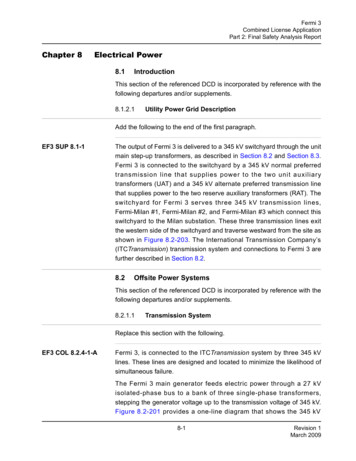
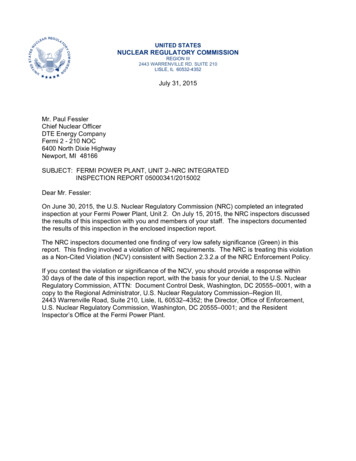
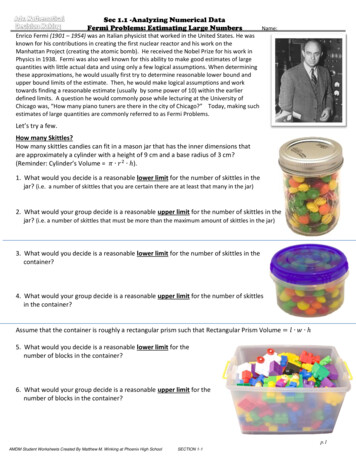
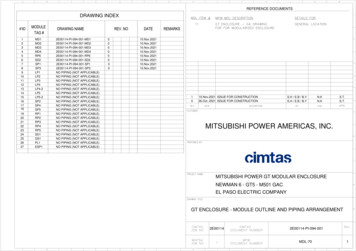
![The GIANO-TNG spectrometer [6269-46]](/img/1/spie-6269-46.jpg)


